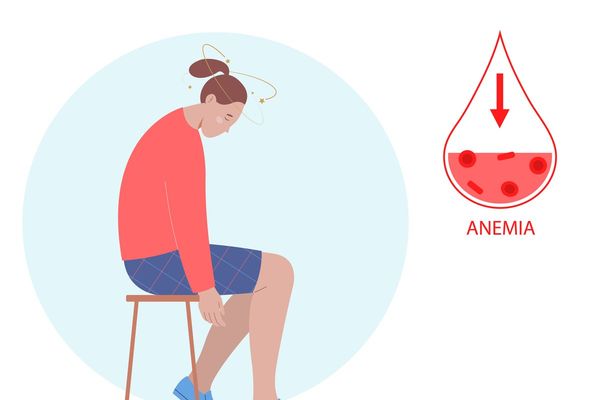Carrie Jones was in her second trimester when her hemoglobin test came back with a low red blood cell count. "I wasn't too surprised because my iron was low before I got pregnant — I couldn't give blood," she said.
Jones is one of millions worldwide diagnosed with iron deficiency anemia (IDA), a common condition where the body lacks iron, so it cannot produce healthy red blood cells to carry oxygen to tissues and organs. Although mild cases of IDA often have no symptoms, if the condition gets worse, the lack of oxygen can lead to physical and mental complications, including heart palpitations, shortness of breath and extreme fatigue.
Women are 10 times more likely to have IDA than men since they lose blood and nutrients during their period, pregnancy or breastfeeding. Women with heavy periods (also known as heavy menstrual bleeding and previously called menorrhagia) are at high risk for IDA because of the blood loss, as are women with medical conditions that cause slow, ongoing blood loss including ulcers, hiatal hernias and gastrointestinal bleeding. A recent study found that race may play a role in lack of iron, citing Hispanic and Black women as lacking iron more often than white and Asian women ages 25 to 54.
The odds of getting IDA are greater for pregnant women than nonpregnant women because pregnant women need to supply enough iron for two. Iron is a big deal: Having enough iron is important for the growth of the placenta and the fetus. And a healthy red blood cell count is also good for mom — iron helps you recover from blood loss during childbirth.
Untreated cases of IDA can cause serious problems for both the mother and the child during and after pregnancy. The good news is that many women can treat IDA with diet and supplements.
Risks to pregnant women and their babies
Pregnant women who have a history of heavy periods, experience extreme morning sickness or are carrying more than one baby are also at risk for IDA. "I was very nauseous throughout my pregnancy and I had terrible morning sickness," Jones said.
Pregnant women with IDA, who make up 42% of all pregnant women in the world, can suffer a range of physical complications that include heart failure as well as a decline in cognitive function (the skills used by your brain to think, learn, remember, and perform simple and complex tasks). One study found IDA led to poor concentration and reduced ability to work in pregnant women. The study also found that the risk of postpartum depression was significantly greater in pregnant women with IDA compared to women who were not anemic.
"Untreated IDA can increase a woman's risk for several pregnancy-related complications, such as preeclampsia, hemorrhage requiring transfusion and death," said Dr. Salena D. Zanotti, an OB-GYN at Cleveland Clinic. "There can be an increased risk of admission to the NICU [neonatal intensive care unit] for babies born to untreated anemic mothers."
Children born with anemic mothers have been linked to low birth weight and premature birth. After birth, infants whose mothers have severe IDA can experience delayed growth and development and an increased risk of infection. Research has also shown an increased risk of death right before or after birth.
Treatment options and prevention
To treat mild cases of IDA, the first step is taking an oral iron supplement. But some women have trouble with high doses of iron because it can cause nausea, vomiting or constipation. "Women who can't stomach the supplement may have to get iron through an IV at the doctor's office," Zanotti said. For Jones, tolerating the oral iron was a struggle that required a little creativity. "At first, I was so happy that all I had to do was take supplements," Jones said. "But the smell and taste made me gag, [so] my doctor told me to take Flintstone vitamins instead — and it worked!"
Guidelines say that every pregnant woman should consume 27 milligrams of iron a day. To help make sense of what someone needs to eat to get 27 mg of iron, a half-cup of instant grits has 7 mg of iron, one cup of cooked navy beans equals 5 mg and 47 pistachio nuts have 2 mg of iron. For some women, eating iron-rich protein like red meat, poultry and fish can help treat IDA. The iron from red meat is absorbed most easily, but for women who do not eat meat, iron-rich options like prunes, peas and iron-fortified breakfast cereal are among the options. For example, one cup of Total Raisin Bran has 18 mg of iron without milk, and one cup of boiled lentils has 14 mg of iron. Food and beverages high in vitamin C, including strawberries and orange juice, can help enhance the absorption of iron from plants and supplements.
"The most important thing a woman can do to prevent IDA is to make sure she is as healthy as she can be prior to pregnancy and to maintain a healthy diet," Zanotti said. "A woman can get iron through her diet but often needs a supplement during pregnancy due to the changes to a woman's red blood cells and due to the demands of the fetus."
More severe cases may require blood transfusions and the help of a specialist.
IDA warning signs
In addition to screening for IDA, Zanotti recommends taking the time to really listen to your body since many pregnancy symptoms can mirror signs of IDA. "Most pregnant women are tired in the first trimester and often the third trimester. Fatigue that doesn't improve after the first trimester or worsens throughout can be a sign of IDA," she said. "A woman may also be dizzy and feel weak. She may have headaches or restless leg syndrome — these are all important symptoms."
Although Jones had no symptoms of IDA, she is thankful for the screening/blood work that uncovered her condition because she was then able to increase her iron levels and had no complications. She gave birth to a healthy baby girl, Allie, in 2018. The whole family takes Flintstone vitamins now.
- 9 Low Iron Symptoms: Could You Have an Iron Deficiency ... ›
- My Heavy Menstrual Bleeding Led to Iron-Deficiency Anemia and ... ›
- Boost Your IDA IQ: An Overview of Iron Deficiency Anemia ... ›
- Postpartum Hemorrhage Is a Deadly Problem - HealthyWomen ›
- Fast Facts About Iron Deficiency - HealthyWomen ›







